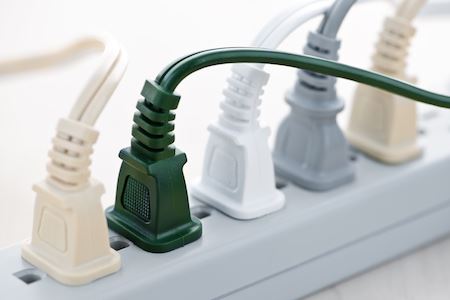Power surges are very brief electrical disturbances. They usually are no longer than a millionth of a second in length, and will vary in duration and magnitude. Then can send thousands of volts of power through the wires, and be destructive to anything in its path.
How common are power surges?
Think power surges rarely occur in your home? Think again.
 Our modern homes use an abundance of electricity to keep up with our lifestyles. And with all of this energy surging into every room, power surges are increasing in numbers. They aren’t just lightning strikes. Instead, studies show that up to 80 percent of surges are created within a home, from things like large appliances turning on and off.
Our modern homes use an abundance of electricity to keep up with our lifestyles. And with all of this energy surging into every room, power surges are increasing in numbers. They aren’t just lightning strikes. Instead, studies show that up to 80 percent of surges are created within a home, from things like large appliances turning on and off.
Are power surges destructive?
Here in the US, most homes are built using 120 volt alternating current. Electricity isn’t delivered to your home at a constant 120 volt rate. Instead, the voltage rises and falls, moving from 0 to 169 volts at any given point in time. Every appliance in your home is created to accept these levels of alternating current.
With a power surge, the voltage shoots beyond the 169 volts. This spike can be harmful enough to destroy the appliance instantly. But in most cases, it merely shortens the life, impacting it again and again until it can no longer do its job.
What causes power surges in my house?
These power surges come from a variety of places.
- One of the most powerful sources is lightning. If it hits near you, it can enter your home in a variety of ways, such as through your cable TV.
- Your local utility company can send out surges through power grid switching.
- It can originate from inside your home as heavy duty appliances such as your air conditioner turn off or on.
How do you fix or prevent a power surge?
As you may have guessed, you aren’t going to stop power surges from external forces any time soon. That said, you can lower your risk by doing a few things inside your home.
Unplug devices you aren’t using. It might sound a little too simple, but if you walk around your house, you’ll invariably find a variety of things idle, rarely used. Unplug the toaster unless you’re using it. Unplug the old VCR you haven’t used in ages.
Upgrade old wiring. If your house was built before the 1980s, it wasn’t designed to handle today’s electrical loads. Old houses don’t have enough power outlets because we simply didn’t have that much to plug in. And over time, wiring wears down, just like other items in your home. If you’ve had frequent blown fuses, lights that flicker when larger appliances turn on, or tripped circuit breakers, it might be time to replace old wiring.
Upgrade circuits. When was the last time an electrician evaluated your circuit panel? Is it designed to work with your lifestyle? Especially in the kitchen, it’s easy to add new appliances and overload circuits. Many of today’s appliances should have their own dedicated circuits.
If you have questions about power surges and how well your home is protected against these destructive acts, we’re happy to evaluate your home and make suggestions for improving efficiency.

